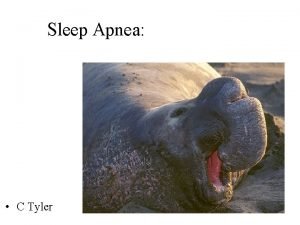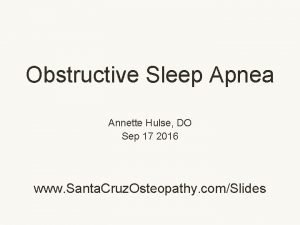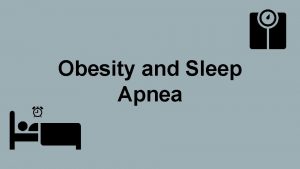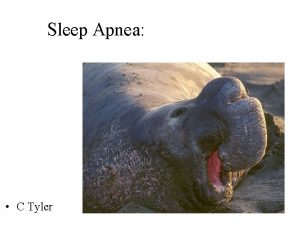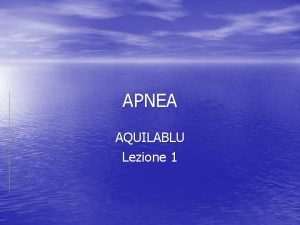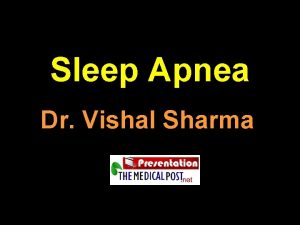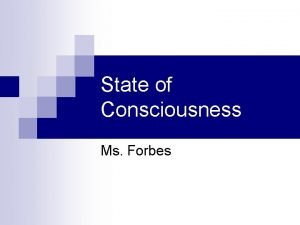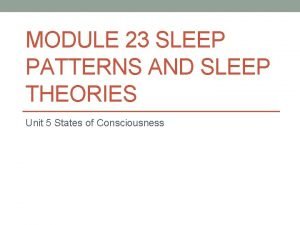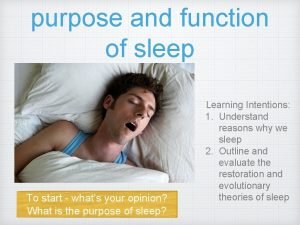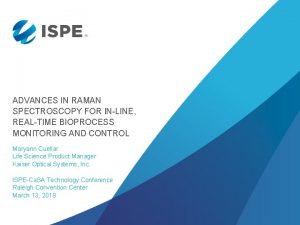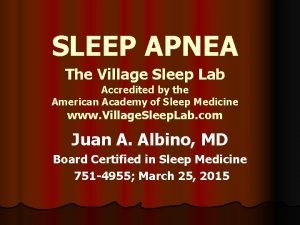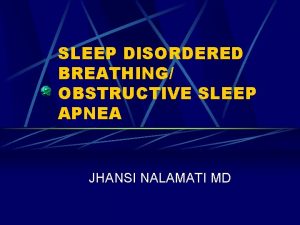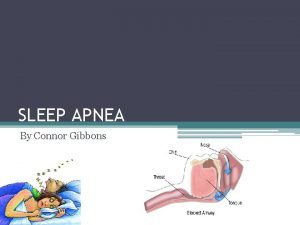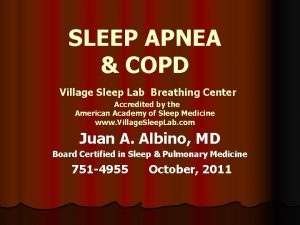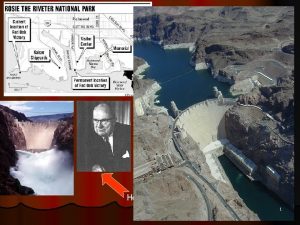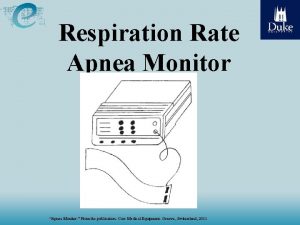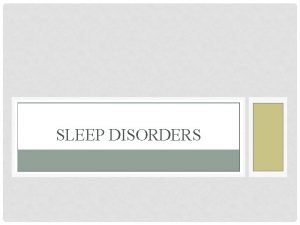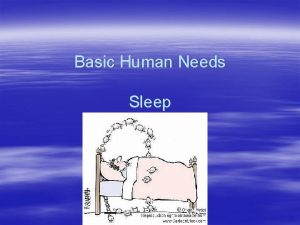Sleep Apnea C Tyler Sleep Apnea Kaiser SF





















- Slides: 21

Sleep Apnea: • C Tyler

Sleep Apnea Kaiser SF Sleep Lab a. k. a. ‘apnea clinic’ Part 1 C Tyler, Sep 2016 Medical Director Kaiser, San Francisco

OSA

What are we going to cover? • • • Brief History of Sleep – Neuroanatomy – Neuro transmitters Importance of Consolidated Sleep – conversely the importance of staying awake… The History of Sleep Apnea Physiology of Sleep Apnea Modern Definitions (criteria) of Sleep Apnea Risk Factors Prevalence Diagnosis Treatment …a quiz

We sleep so we can be awake: Excess Daytime Sleepiness (EDS) – – Exxon Valdez Three Mile Island Chernobyl Union Carbide at Bhopal 100, 000 MVAs annually due to driver drowsiness or fatigue • $3, 000, 000 / year – Libby Zion 1965 -1984 • Phenylzine (Nardil) MAO-I + Meperidine + Haldol -> Seratonin Syndrome – International Classification of Sleep Disorders (ICSD) • 88 sleep-related disorders

Sleep in other Species • • • Humans: 8 h Duck 10. 8 h Horse: 2. 9 h Dolphins: Put half a brain to sleep at a time Fruit Flies: Herbivors need time to forage Predators eat huge meals Birds don’t go limp during REM sleep Flamingos sleep on one foot, bats hang upside-down

History of Sleep Medicine • • • 1875 Electrical activity in brains of animals – Caton 1880 Narcolepsy described – Gelineau 1929 ‘Electroencephalogram of man’ – Berger 1937 NREM described - Loomis 1951 REM Sleep described – Kleitman 1960 Sleep-onset REM in narcoleptics – Vogel 1964 First Narcolepsy Clinic (Stanford) 1972 Destruction of SCN eliminates circadian rhythms 2007 RLS in 6% of population but 34% in iron deficient patients 1989 Sleep deprivation results in death of rats - Rechtschaffen et al. 1989 First Fellowship Training Programs 1991 American Board of Sleep Medicine


Deep Brain Structures and Sleep • 1920 s: – Diabetes Insipidus caused by Hypothalamic lesions – (sleepiness coincided)

The Isolated Forebrain: Frederick Bremer 1892 -1982 cerveau isolé • complete midbrain transection – EEG slow waves and spindles – structures below midbrain facilitate wake-state – Hypothesis: ‘wake’ d/t spinal sensory stimuli • mid-pontine transection (lower) ‘cerveau encephali’ – activated / wakelike forebrain EEG – structures between midpons and upper midbrain generating a wake state


What is Sleep? • complex reversible state characterized by: – behavioral quiescence – diminished responsiveness to external stimuli • maintained by – CNS networks – Specific neurotransmitters

Diurnal Cycles: the tides and sleep

Staying in synch with our environment

The Earth’s spin rate is slowing down • The earth spins once every 24 hr w. r. t. the Sun – …every 23 h, 56 min, 4 sec w. r. t. the Stars • Today is 1. 7 milliseconds longer – than this day one century ago – Requires a‘Leap Second’ every 2 years or so

Biological Clocks: • What for? • Why not just stay awake permanently?

Theories of sleep • Restorative and somatic growth theory – Facilitation of anabolic processes • Metabolic theory – energy conservation • Survival theory – protective and adaptive behavior • Neural growth and processing – neuronal synaptic plasticity – brain development – restoration, learning, and memory consolidation • Evolutionary Specialization to unique environmental circumstances

Why do we Sleep? • Brain recuperation: • Adaptation to special circumstances: – Activity of pray and predators – Non-competitive adaptation • Energy Conservation: – Hibernation • Adaptation to habitat: – Light/Dark – Hot/Cold

Hormones: The night life of …

Neural Control of Sleep Wake, NREM sleep, and REM sleep • generated/maintained by different neurons, networks, neurotransmitters • • Primary Sleep and Wake Neurotransmitters Glutamate: Primary excitatory neurotrans ACh: main REM neurotrans GABA: main NREM neurotransmitter • Wake Neurotransmitters • • Glutamate acetylcholine dopamine histamine hypocretin (orexin) norepinephrine serotonin • Sleep Neurotransmitters • GABA, gamma-amino-butyric acid • • • acetylcholine adenosine Glycine: spinal cord PRINCIPAL (ARAS, RHT) basal forebrain, PPT/LDT subst nigra, Br. Stm, vntrl tgmnt tuberomammillary nucleus lat hypothal prefornical locus ceruleus Raphe nuc, thalamus prinicple NREM VLPO, Thal, Hypothal, basal forebrain, cortex principle REM sleep transmitter (homeostatic generator) basal forebrain (inhib motor)

The seductive call of sleep: – More powerful than hunger – More powerful than sex – More powerful than money
 Osa labaka
Osa labaka Annette hulse
Annette hulse Sleep apnea symptoms
Sleep apnea symptoms Kaiser sleep clinic
Kaiser sleep clinic Apnea educacion fisica
Apnea educacion fisica Scivolo prono in apnea
Scivolo prono in apnea Apnea
Apnea Adults spend about ______% of their sleep in rem sleep.
Adults spend about ______% of their sleep in rem sleep. Module 16 sleep patterns and sleep theories
Module 16 sleep patterns and sleep theories Module 23 sleep patterns and sleep theories
Module 23 sleep patterns and sleep theories Come sleep o sleep the certain knot of peace
Come sleep o sleep the certain knot of peace Module 23 sleep patterns and sleep theories
Module 23 sleep patterns and sleep theories Kaiser ferdinand nordbahn
Kaiser ferdinand nordbahn Kaiser spider excavator
Kaiser spider excavator Kaiser wilhelm ii deformity
Kaiser wilhelm ii deformity Kaiser mfa northern california
Kaiser mfa northern california Kaiser permanente letterhead template
Kaiser permanente letterhead template Kaiser permanente spokane walk in clinic
Kaiser permanente spokane walk in clinic Wilmshaven
Wilmshaven Raman probe bioreactor
Raman probe bioreactor Labor management partnership environment
Labor management partnership environment Kaiser application status
Kaiser application status
